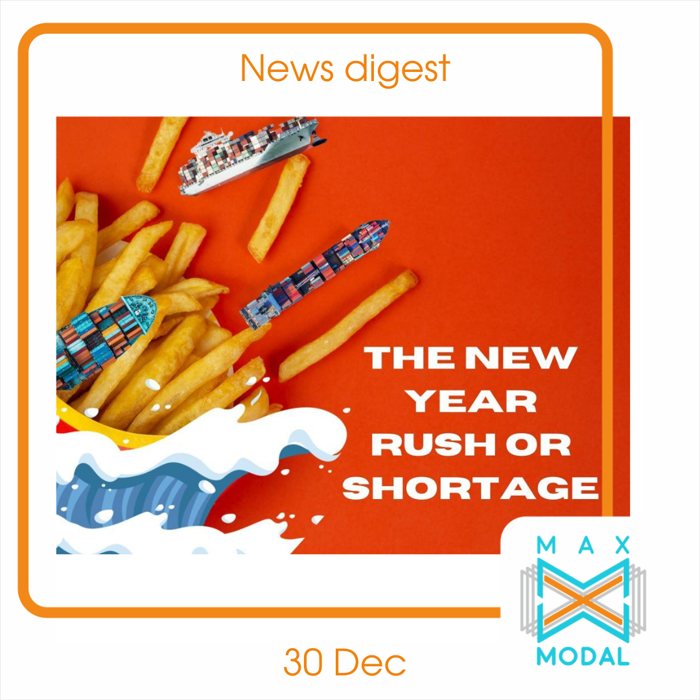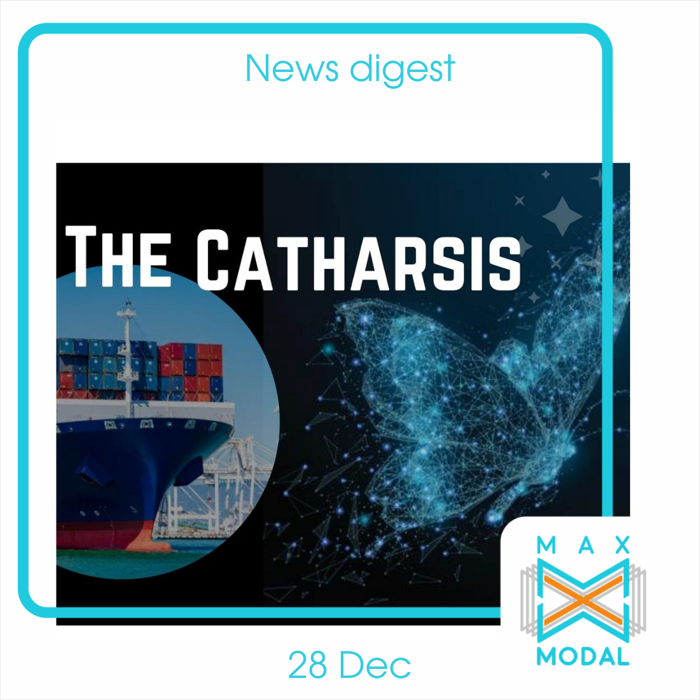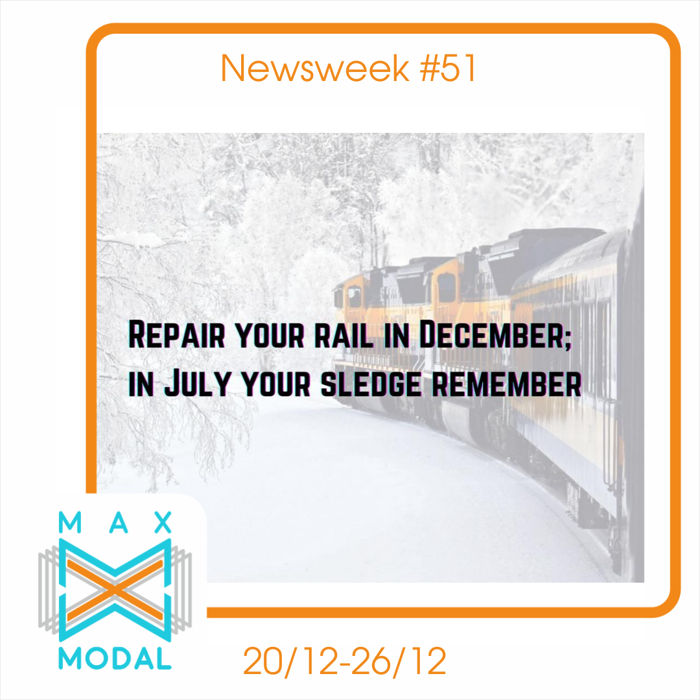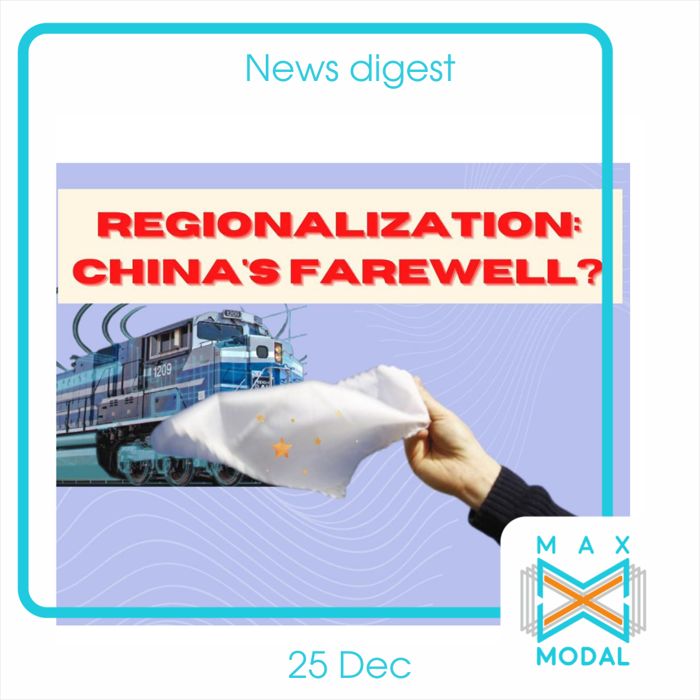Shortages are making every meal actually happy: how companies are bracing up in the anticipation of the Chinese New Year and find ways to deliver their cargo.
Although Chinese New year is not the end of the world, sometimes with all the delays, it does seem like one because China remains a crucial destination for many sources and suppliers and it is impossible to eliminate it from the logistics chain. As major ports continue experiencing logjams, shortages start spreading way beyond and now reach fast-food chains that cannot ship their cargo on time. Recently McDonald’s had to rent a cargo jet after it had temporarily limited the sale of medium- and large-size French fries in Japan because of delays loading vessels at the Port of Vancouver. Big companies are very cautious with positive predictions for 2022 and so far expect 2022 to start with shortages as demand is not showing any signs of slowing down and Omicron is creating additional constraints, despite the fact that the global container trade has grown 1%. The will be a pre-holiday cargo spike in the first week of February because some South China barge services will remain suspended. In other parts of the world, some companies halt their shipments in order to try to clear backlogs. In the rush for storage that is clearly going to be equal to gold, others extend their feeder boxship charters as well as place new orders for container vessels. The increase of ports’ capacities is also on the list of priorities for the majority of the players. Anticipating the coming year, Hutchison Port’s terminal in Spain will receive $68 million for development. The initiative aims to provide relief to the busy Port of Barcelona that has moved 3.2 million TEU in November, a 21.6% increase on 2020 levels. APM Terminals Apapa, Nigeria’s largest container terminal, has followed suit with the investment of $438 million in upgrading its facility with modern cargo equipment. The struggling Port of LA that has been an ultimate start of handling record volumes of TEU will also get its share of findings from Evergreen. It will spend nearly $70 million on more containers and cranes. In fact, California’s ports (the Port of Oakland in particular) come up with the idea of widening the ship turning basins to accommodate larger container ships calling North America. The widening of the Oakland Harbor turning basins is expected to be a major infrastructure improvement.
As competition increases, authorities are determined to speed up on the initiatives that could help decrease the lines’ already enormous influence by updating FMC policies that would allow easier procedures of filing complaints about unreasonable business practices that result in financial or operational harm. However, the problem with shipping lines is much more complicated and involves different aspects that include cybercrime, accusations that lines do not fulfill their contract commitments, lack of transparency. This year has seen numerous court cases, which prove that FMC has a long way of adjusting its policies in order to meet the monopoly-free agenda.
Is only the shipping sector under cyber-attacks? Rail is also under threat because all modes are now easy targets since everyone’s attention is at the congestion and supply chain disruptions. Hence, UNIFE is calling for full cooperation in the European cybersecurity arena and a collaborative approach between rail stakeholders. Many rail companies are advocating for digitalization, which is a great vision for the future, however, it means that a deeper analysis of all operational cybersecurity-related processes is required to protect companies’ data and operation flow. The UK has recently defined its strategy based on more diversity in the workforce, leveling up the cyber sector across all UK regions, expanding offensive and defensive cyber capabilities. Another pain point for the EU railways was floods, particularly in Germany. Experts estimate that the damage was so severe that the consequences of it will last in 2022 as reconstruction is still in progress and concrete prognoses for recommissioning are not yet possible.

Shipping lines are shedding off the old business models and welcoming the New Year with more flexible and agile approach. What will it take to win the game in the coming months?
Through hardships to stars or a year of transformation – this is how 2021 can be described if we look at the major shift in the lines’ business models towards becoming full-blown providers of the inland logistics services. What has caused such catharsis? Ever Given stuck in Suez disrupting the game, stratospheric rates that left shippers almost bankrupt and logjams all over the world with epic piling up have led to major reconsiderations of the ways companies operate. What tops the picture in December is the disruption due to machinery failure that left a containership prang in Taiwan. The saga of an asset-light business model that included leasing warehouses, trucks and aircraft, and using contract labor for a long time, and maintained flexibility with minimum capital expenditures has ended. The crisis has proven that relying on third parties to make on-time deliveries is a losing game, thus In 2021, the major carriers invested heavily in becoming integrated logistics supermarkets from which customers can order individual services, such as customs brokerage or port-to-port transportation. It is clear that for big lines it means more agility with an extension of end-to-end operations but what about shippers? They can also benefit from it, as this extension will give more room for competition and a variety of services. However, when the lines acquire other companies, and we have seen it happening over the course of this year, they have to put tremendous effort to make this integration smooth, which requires organizational changes, IT changes, customer integration. Simply sticking together end-to-end will not do anything, and not many understand it because usually, the main reason for acquisitions is the desire to get in the game when the post-acquisition strategy is not defined.
In addition, it is a people-heavy business and if forwarders want to stand the competition, they will have to invest in localized knowledge and better forecasting, otherwise, shippers will. They are already spending time to improve their forecasting, and that will help them ask for contractual changes, based on relationships, rather than transactional. Their appetite will only keep growing, so 2022 should be the year when the industry needs to evolve the way it manages and executes supply chains. After all, 2021 has given all the necessary tools for it and luckily, ports will receive additional investment too. In the case of the US, they may come from abroad with Qatar planning to invest $10 billion. The east coast is past due for improvements while the west coast, although it is still problematic, holds the best potential, according to analytics.
Like a spider web, railways continue to expand and connect the most vital facilities. For a while, a part of the North-South transport corridor passing through Azerbaijan was under reconstruction, and recently it has renewed its work. Apart from connecting the country with Russia, the railway line is essential for the connectivity of the Abheron peninsula with the rest of the region. The upgrades also concern the UK where under a wide-ranging program of works Network Rail is improving capacity and relieving bottlenecks in and around Manchester. Despite the recent announcement that many capital projects including the one dedicated to the provision of a high-speed line, this initiative has not been crossed out. Over the Christmas holidays, these improvements are a crucial part of the Transpennine Route Upgrade, which will better connect the North and allow more trains to run in the future. In the meantime, the trend of many companies going east has already been highlighted, and DB cargo Eurasia jumps on it too with a new connection between China-Europe through Poland. The country has been in focus for many countries, so who knows, maybe Poland will have all the trump cards to become a new rail frontrunner in the region?

Many have already predicted that the coming year will be transformative for all modes, and the current state of affairs gives clear hints that rail will be the first on the list experiencing it, while shipping and airfreight sectors are battling never-ending congestion and cosmic rates. Metamorphosis will occur not only thanks to the already occurring changes such as introduction of the new services and grants for the development of new facilities but also if the EU will take the reign in its hands and shift China on the pedestal of the New Silk Road champion. However, this mission will not be easy to crack especially since China-Europe route remains the busiest in handling TEU.
Another forecast that we can see unfolding these days is the reconsideration of supplier relationships by many players. Near-shoring is becoming a new trend with European companies switching their focus to the east, and the US ones concentrating on Latin America. As costs keep increasing, it seems to be the only strategy that could secure a competitive position of the companies. Since MSC has outrun Maersk with the size of its fleet, will the size of the assets no longer be a battling ground for competition? What other predictions will come true and how are the new rules going to affect the market? Follow the updates on MAXMODAL.

With China becoming less favorable, does it mean it is time to wave it with a handkerchief? It seems like it is Eastern Europe’s moment to shine.
Reconsideration of suppliers has been in the talks for months since the costs started to rise. Initially, China was everyone’s favorite since sourcing from there used to be indeed the most efficient way. However, the rules have changed and the new reality requires new approaches. Many European players are planning to expand to Eastern Europe in 2022. What are the benefits? Sourcing from there or Mediterranean countries significantly cuts lead times when those from Asia to Europe have almost doubled due to supply chain disruption. At the same time, in the US, everyone is switching focus to Latin America, so near-shoring is set to become a global phenomenon that we are most luckily to start the new year with. However, it does not mean that Asia is forgotten – Maersk has sealed the deal of a $3.6bn acquisition of Hong Kong-based LF Logistics. The move is taking the giant further down its avowed corporate path to becoming a logistics integrator. Although Maersk’s “buying spree” has boosted the company’s assets greatly, it has still lost to MSC in the race of becoming the biggest line. The latter has “checkmated” Maersk thanks to the acquisition of 67% of Log-In – Logistica Intermodal S.A, a Brazilian company. With the new balance of power, what will be the next battleground for competition?
No matter the potential redirection of universal focus to Eastern Europe, the China-Europe rail direction remains exceptionally busy. Having transported 436,632 TEU so far, the market has set a new record. This is why new services are of great importance. The most recent one is the launch from Guangzhou on the southeast coast of China, to the main port of Germany: Hamburg. As congestion remains a pressing issue, rail becomes a sufficient alternative for cargo transportation. China senses the new direction of the wind and hurries to strengthen its presence in Eastern Europe too by introducing the train to the Polish harbor of Gdynia. After all, nobody has expected the country to ease its clawed grip off the region. However, not everything is so smooth. One of the biggest concerns regarding the New Silk Road includes the launch of regular chemical trains because there is no standardized approach to this segment of the industry. In addition, it is the notorious congestion that puts this initiative out of scope. At the same time, the Middle East is not slowing down and the Islamabad-Tehran-Istanbul railway train has finally seen the light. The corridor has great potential and more players such as India and Bangladesh are considering joining it in order to realize a faster transport link to Europe. Besides, the new train is eco-friendly, which aligns with the standards of the new sustainable agenda. Can the rail really take the congestion blast solely on itself? Is there a capacity for it? The US hopes so. As experts report no significant improvement at the Ports of LA and Long Beach reporting historical highs, the authorities switch to rail and give the Port of Long Beach a grant of $52.3 million for development. The rail capital improvement program aims to utilize moving more cargo by on-dock rail as it is cleaner, more efficient, and reduces truck traffic. The construction of the new facility will begin in 2023 and is planned to finish by 2032. Otherwise, the Port will not be able to handle all the incoming TEU. The elevated throughput concern Europe too where the volumes in the Port of Rotterdam surpass 15 million TEU. The problem lies in the fact that the ports all over the world are not growing fast enough and this cannot address the skyrocketing demand. As the result, lines continue deteriorating their calls to avoid further delays. For now, the authorities will continue to emphasize and encourage the importance of digitization, cooperation and data sharing to provide a better response to the global pressure on the logistics chain – now and in the future. What also adds up to piling issues is the post-Brexit policies that many have appeared unprepared for, thus local governments will be forced into unfavorable policies.
Not only ocean freight is extraordinarily expensive. Airfreight spot rates have been surprising shippers for weeks, and although the market has seen a small decline recently (the figures from China to the US have dropped to $13.82/kg), no one is really hopeful that it will last especially when there is a threat of lockdown in Europe lingering in the air. If they are imposed, consumer spending is expected to increase which will put more pressure on supply chains. Logically, companies are already bracing up and start expanding their assets. In the case of UPS, the company has made a major freight order from Boeing, which has broken its record in freight sales this year. Singapore Airlines follows suit and makes a similar strategic move by teaming up with Airbus to purchase freighter aircraft. It will burn up to 40% less fuel on similar missions to provide better operating economics, and boasts a longer range that offers greater flexibility in aircraft deployment.

We have not even turned the page of the calendar over for 2022, but the promised increase in rates is already here.Traditionally, the EU-China is the most affected direction with prices going up to $11,900 per FEU, and the same is true for airfreight with early bids averaging $16/kg. With port congestion and demand remaining high, this monstrosity is expected to continue beyond Christmas. The setbacks seem to overshadow any improvement globaly with big companies canceling their calls on the most heavily affected routes. As another means to tackle the problem, some of them start upgrading their network by connecting facilities that one would not think about in the first place.
The rail goes for more collaborations to strengthen its positions this time thanks to a new joint venture among Russia, Hungary, and Austria. In addition, the recent advances are topped with the new China-Europe route. Indeed, the role of railways will only keep increasing especially in light of the upcoming post-Brexit rules regarding transportation. The current state of things demonstrates that many players are simply not ready for the coming changes and there is a risk that old problems might make a comeback. Keep an eye on MAXMODAL for fresh updates.

A reset of the China-Europe’s main rail artery? The new task on the coming year’s “To do” list.
Although rail is not directly affected, while Omicron is marching over China, it still does not mean that this sector is going to be immune to the consequences of potential ports closure. The New Silk Road has surely sparked a lot of hope that it is going to play a key role in the sector’s recovery, however, a close examination has revealed that it is still suffering issues that have been present for years. Some of them include problems with restricted goods regulations, capacity shortages, price instability or flow imbalances. Are we in for a major strategic reset? It mostly depends on the powerplay between Europe and China. Experts say that Europe should take the lead, otherwise it will not be able to stand the competition and China will advocate for the policies that will be beneficial only for it. Finally, another focal point that would make a difference in improving the New Silk Road and its services is the scheduling of trains and the balancing of eastbound and westbound flows. The destiny of the latter is closely tied to China’s future policies regarding subsidies. The government will phase them out by the end of 2023 which is expected to make forwarders focus on quality over quantity, especially in light of congestion experienced this year. Smaller rail terminals will shut down and give room to bigger ones that no longer need government support. Hungary, on the contrary, relies on the aid of the authorities, as it fears the rise of rail freight costs in 2022 due to elevated energy prices. At the same time, Spanish railways have been disrupted by the flood – the line between Madrid and Iran, a gateway of high importance for rail freight to and from the north-west of Europe, still remains closed. On the other side, Port Klang becomes the brother in misfortune where operations have been stopped because of the weather conditions.
In the battle against shipping lines for contracts at reasonable prices, shippers were destined to lose, taking into account the influence of the giants’ on the market. The winners are expected to seal agreements with clients at record figures. They are on track to earn $115 bn to $120 bn in profit with the average of the bids coming in $11,900 per feu on China to North Europe trade. Left-out forwarders are firing complaints about unfair competition claiming that they will no longer find space for their cargo in the new structure created by big lines unless they venture into the less favorable spot market. The current state of the EU law of competition does not live up to the new challenges, thus many advocate for reconsideration of the provisions to make them up to date. Sounds familiar, does not it? The US has been trying to influence the unstoppable shipping lines with the help of FMC, so now it is the turn of the European Commission to step in; otherwise, prices and reliability are going to be at risk of the unprecedented increase of cost of shipping goods, as well as enormous delays in the delivery. The US is already calling big carriers for collaboration and implementation of wiser strategies (e.g. regarding utilization of available terminal capacity on the West Coast). Besides, the kings of this chessboard are not going to slow down on their expansion with MSC placing a $6.4bn bid to buy out Bolloré Group’s African logistics business. For the company, this is a region of strong growth this decade and major developments in the future to strengthen its competitiveness. Apart from conquering new land, companies have significantly increased their spending on ships – both newbuilds and secondhand – thanks to the capacity crisis. The updates report the record amount since 2008 estimated at $147bn.
“Go green or go home” has been the leitmotif of 2021 and as an encouragement for everyone choosing sustainable development, Port Bronka is introducing a 10% discount. It will be applicable for mooring and quay operations. It is especially relevant for shipping companies operating in the Baltic and North Seas and other water areas that are part of the special Emission Control Areas. Lithium-ion battery systems also allow for zero-emissions port visits as well as modern two-stroke engines that cut emissions further.
It must be the tough times that are pushing the statistics of cargo theft higher in the Middle East. 76% of stolen cargo is from warehouse and storage facilities, with high-value goods such as electronics. This poses a big threat to higher volumes of cargo since the economies of the Gulf countries are returning to the pre-pandemic levels. Hence, many organizations are going to strengthen global transport supply chains through the implementation of international standards such as TIR for compliance management and security. The tough reality is also true for Hungary where electricity prices are going up.






